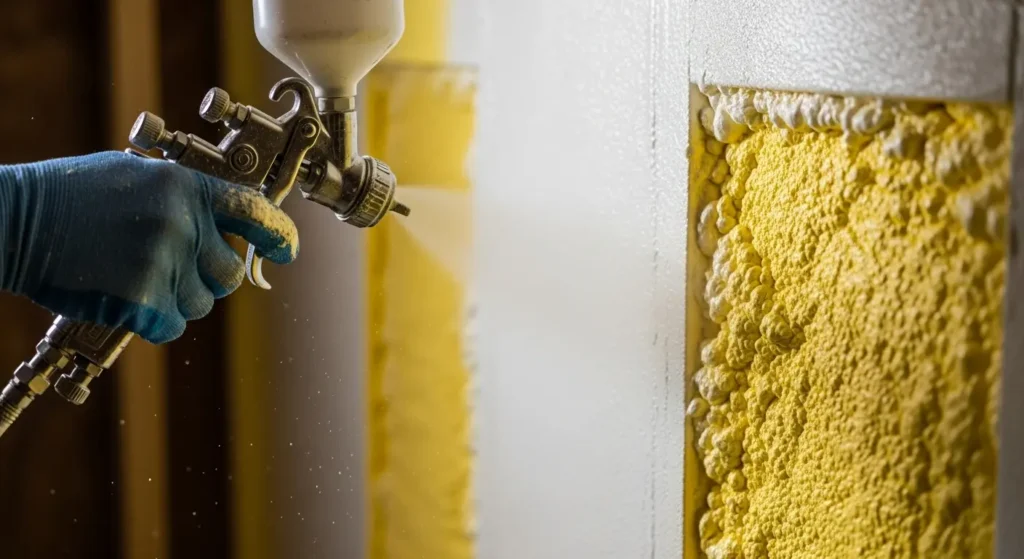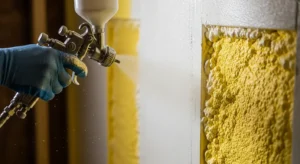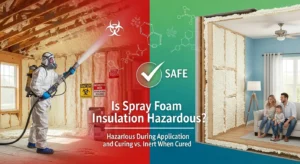Spray foam insulation has become one of the top choices for homeowners and builders in New York City. It’s energy-efficient, long-lasting, and provides excellent air sealing for homes and buildings. But once the foam is installed, many property owners wonder can you paint spray foam insulation?
The short answer is yes, you can paint spray foam insulation. However, it’s not as simple as grabbing a paintbrush and coating it like you would a wall. There are specific steps, safety precautions, and materials that need to be used to get the best results.
If you’re planning to install or already have spray foam insulation in NYC, this guide will help you understand how painting works, when it’s recommended, and what to avoid for a lasting finish.
Understanding Spray Foam Insulation Before You Paint It
Spray foam insulation is made by mixing two chemicals isocyanate and polyol resin that expand when combined, filling gaps and creating an airtight seal. It’s applied as a liquid and quickly hardens into a solid foam.
There are two main types of spray foam insulation:
-
Open-cell spray foam: Lightweight, flexible, and less dense, often used in interior walls and ceilings.
-
Closed-cell spray foam: Rigid and more moisture-resistant, ideal for basements, crawl spaces, and exterior walls.
Before you think about painting, it’s important to know which type you have. Closed-cell foam has a smoother, harder surface that’s easier to paint, while open-cell foam is softer and more porous, requiring more prep work and a specific kind of paint.
Why Would You Want to Paint Spray Foam Insulation?
Painting spray foam insulation isn’t always necessary, but there are valid reasons why homeowners or insulation contractors might recommend it.
Here are a few common ones:
-
Aesthetic purposes: If the insulation is exposed such as in a garage, attic, or basement painting gives it a cleaner, more finished look.
-
UV protection: Direct sunlight can damage exposed foam over time. A coat of paint helps block UV rays and extends the insulation’s lifespan.
-
Added durability: Paint adds an extra layer of protection against moisture, dust, and wear in exposed areas.
-
Building code compliance: In some NYC building codes, spray foam used in commercial spaces or open ceilings must be covered with a fire-resistant coating or intumescent paint for safety.
So, while painting is optional in some cases, it can be an important finishing step in others.
Read More: Why Spray Foam Insulation is the Best Choice for NYC Homes
Can You Paint Spray Foam Right After Installation?
No, this is one of the most common mistakes people make. Spray foam insulation must be fully cured before it’s safe to paint.
When spray foam is first applied, it goes through a curing process where the chemicals react and solidify. This process can take anywhere from 24 to 72 hours, depending on factors like:
-
The foam’s thickness
-
Temperature and humidity in the space
-
Ventilation levels
If you paint too soon, you can trap moisture or uncured gases under the paint layer, leading to peeling, discoloration, or unpleasant odors.
Professional spray foam insulation contractors in NYC always recommend waiting at least a few days after installation before painting.
What Type of Paint Works Best on Spray Foam Insulation?
Not all paints are suitable for spray foam. Because the foam expands and contracts slightly with temperature changes, you need a paint that adheres well and can flex without cracking.
Here are the most recommended paint types:
Acrylic Latex Paint
This is the most popular choice for interior spray foam insulation. It’s water-based, low in VOCs (volatile organic compounds), and provides a smooth, even finish. Acrylic latex paint works well for both open-cell and closed-cell foams.
Intumescent Paint (Fire-Resistant Coating)
For safety compliance, many insulation contractors use intumescent paint, especially in basements, attics, or commercial properties. When exposed to heat, this paint expands and forms a protective layer, slowing down the spread of flames.
UV-Resistant Paint
If your foam insulation is in a place that gets sunlight like a garage or near windows, a UV-resistant or elastomeric coating is ideal. It prevents yellowing, cracking, and degradation caused by sunlight exposure.
Avoid using oil-based paints or solvent-based coatings. These can chemically react with the foam surface and cause it to soften, bubble, or deteriorate over time.
How to Paint Spray Foam Insulation: Step-by-Step Overview
If your foam insulation is fully cured and ready, painting it the right way ensures durability and a professional finish. Here’s how experienced insulation contractors usually handle the process:
1) Inspect and Clean the Surface
Make sure the foam is dry, hard, and free from dust, dirt, or oil. If there are uneven surfaces or excess foam buildup, lightly trim them with a utility knife or sandpaper.
2) Protect Adjacent Areas
Cover nearby surfaces, wiring, or fixtures with plastic sheeting or painter’s tape. This keeps overspray or paint drips from landing where they shouldn’t.
3) Apply a Primer (Optional but Recommended)
For the best adhesion, especially with open-cell foam, apply a water-based primer before painting. This seals the surface and prevents excessive paint absorption.
4) Paint with a Brush, Roller, or Sprayer
Use long, even strokes to coat the foam evenly. Two thin coats are better than one thick layer, as this prevents dripping and allows each coat to dry properly.
5) Allow Proper Drying Time
Let each coat dry fully before adding another. Depending on humidity and temperature, this may take 6–12 hours per coat.
When done right, the foam surface should have a smooth, clean finish that’s resistant to wear, moisture, and UV damage.
Common Mistakes to Avoid When Painting Spray Foam
Even though painting foam is fairly simple, a few common errors can lead to poor results:
-
Painting before the foam cures: Always wait at least 24–48 hours.
-
Using the wrong paint type: Avoid solvent-based or oil-based paints that can degrade foam.
-
Skipping ventilation: Always ensure good airflow during painting to avoid inhaling fumes.
-
Ignoring fire safety codes: NYC often requires a fire-retardant coating in exposed insulation areas, don’t skip this step.
If you’re unsure about the right materials or process, it’s always best to consult professional spray foam insulation contractors for expert guidance.
When Painting Spray Foam Becomes a Requirement
In New York City, building safety codes sometimes require that spray foam insulation be covered with a thermal or ignition barrier. This includes garages, mechanical rooms, and commercial spaces.
Painting with a fire-rated intumescent coating is one way to meet this requirement. These paints are tested to slow flame spread, protect the foam underneath, and give firefighters more time to respond in case of a fire.
In fact, some spray foam insulation companies in NYC include intumescent coating as part of their insulation services. It not only provides safety but also gives the foam a clean, uniform finish.
Does Painting Affect Spray Foam’s Performance?
When done correctly, painting does not affect the performance or insulation properties of spray foam.
The foam’s thermal resistance (R-value) remains the same because paint only adds a thin surface layer. However, painting can help extend the foam’s life by:
-
Blocking harmful UV rays
-
Protecting against moisture and dirt buildup
-
Sealing small surface imperfections
This means painting is not just cosmetic, it can also help maintain your home’s energy efficiency and indoor comfort.
Maintenance Tips After Painting Spray Foam Insulation
Once your foam is painted and dry, maintenance is minimal. Here are a few simple tips:
-
Check for cracks or peeling paint once a year, especially in high-humidity areas.
-
Avoid using harsh chemicals or solvents when cleaning the painted surface.
-
If repainting, lightly sand the surface and clean it before applying a new coat.
-
Ensure no water leaks or condensation build up behind the foam.
Proper care ensures that both your insulation and paint coating stay in great condition for years.
Also Read: Is Spray Foam Insulation Worth the Investment
Hiring Professionals for Painting Spray Foam in NYC
While some homeowners attempt to paint spray foam themselves, it’s often best left to professionals especially in commercial buildings or attics where safety standards are strict.
Professional spray foam insulation contractors understand how to select the right paint, apply it safely, and comply with NYC building codes. They can assess whether your foam requires a fire-resistant coating or if standard latex paint will do the job.
They also have specialized tools, such as spray rigs and safety ventilation systems, that ensure even application and proper curing without affecting indoor air quality.
A Fresh Finish with the Right Expertise
Painting spray foam insulation can transform dull, exposed areas into clean, professional-looking spaces while adding protection from sunlight and moisture. When installed and painted correctly, spray foam remains one of the most durable, efficient, and low-maintenance insulation options available.
Whether you’re insulating your home, garage, or commercial building, always trust experienced insulation contractors in NYC who know how to handle every stage from installation to finishing touches.
For high-quality spray foam insulation, rely on the expertise of AirSeal Insulation Systems. Their skilled team offers professional spray foam insulation services, including installation, repairs, and finishing, ensuring your space stays energy-efficient, comfortable, and beautifully finished year-round.




